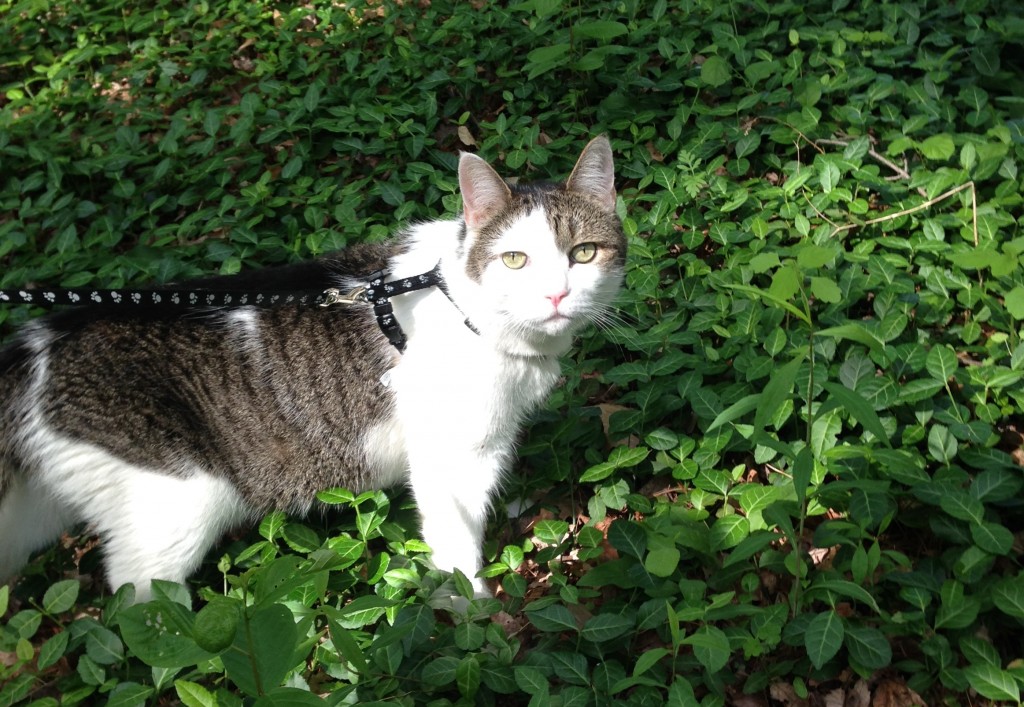So, a long post now that the knife’s edge is blunted a bit.
Cats and cat ownership has long been a big part of my emotional anchoring.  I got my first cat when I was eight (he was Italian, no really, we lived there at the time) and he was with me through the angsty teen years and through college.  He lived 18 years with us before finally succumbing to old age in 2004. Long time friends may even remember that post. And then the first cat I got as an adult was Ozy. Again, long time friends may remember the post I made the day the day after we picked him out. I’d always hoped Ozy would live as long as Midnight did.
But we were not to be so lucky. About a month ago, as a result of a change in his eating habits (He was -always- a food motivated cat, more labrador than cat sometimes), Amanda found a lump in him. And again, I’ll link to a post where you can read more about that and what he meant to us. It quickly became obvious that this was not something that was treatable, and that we had a limited amount of time with him.
Over the past month he ‘rollercoastered’. Â He would rally and have good days, and then other times he’d go downhill rapidly. We kept looking for signs as to when it was time, and we kept seeing that the ups were losing out to the downs. Â He went from not eating his regular food to eating tastier dry food to eating quality wet food to eating the equivalent of junk food. Â But still, wit a pill at mealtimes, even as recently as Thursday he had an up day where he ate 5 (small) cans of food across the day; on Friday he ate two cans in the morning, but would barely eat half a can in the evening.
He wouldn’t give us clear signals though. Â He didn’t become overly reclusive, still jumping up on Amanda’s lap in the evenings and purring, still coming running at mealtimes even though he wasn’t eating, and generally behaving catlike. But we could see his body wasting and he had a lot less enthusiasm and energy than he had 6 months ago when he would bolt down his dinner and go after Tica’s, or when he would attack her aggressively.
It was clear that our cat was sick, getting sicker, and wasn’t going to get better. Â And we could see that he was dehydrated and in a lot of discomfort. Â We found spots where he’d vomited. We didn’t want him to suffer needlessly. We didn’t want the catsitter to have to be the one who was there with him at the end. We wanted him to go on a good note and in a way where we could say goodbye properly.
saturday we could see things were rough, but weren’t sure. Sunday morning we knew we needed to discuss it. And on our way back from thrown weapons practice we made a decision and came to peace with having made it. Â When we got home and he asked for food I gave him some more, but again he wasn’t eating enthusiastically. Â After naptime we gave him some fish, which he enjoyed, and called in a vet we knew well enough to be comfortable with, but weren’t socially connected to.
We took Ozy out on the deck, because he loved being outside even though he wasn’t an outdoor cat, only going out when we occasionally took him out on his harness. And J came out with us and loved playing in the sunshine. Ozy wanted to go down the stairs to the yard, so we let him, and we walked him all around the yard. Yesterdays picture was from that time. It was the most animated he’s been in months.
Shortly after, the vet showed up. Â We brought Ozy back to the deck and sedated him. Then we brought J over to say goodbye to him, which he did, waving, saying bye-bye and giving a kiss. Much of it at our prompting because he is too young to understand. And then we killed our kitty so he wouldn’t go suffering or alone, but could go outside in the sunshine happy. It was quiet. It was peaceful. There was no spasms, no meows, no protests. We brought Tica out to see. Not sure she understood either. And we said goodbye.
It was a beautiful day, and it was everything we wanted it to be. It was perfect. And yet I still can only hope that helps in the long run because it isn’t helping in the short run.
Goodbye to the cat who picked me in the shelter.
Goodbye to the cat who hid for his first week with us.
Goodbye to the first cat I gave a name to.
Goodbye to the cat with the awesome big paws and extra toes who didn’t care if you touched them.
Goodbye to the cat who got out of the house and had us sick and worried that we lost him, but showed up the next morning for breakfast (always food motivated).
Goodbye to the cat who ate a corn cob and sent Amanda with him to the Tufts hospital only hours after she’d graduated from there.
Goodbye to the cat who would jump up and settle down on my desk while I was trying to get things done.
Goodbye to the cat who was always getting on the counters looking for food scraps.
Goodbye to the gentlest cat on four feet.
Goodbye to the cat who used to crawl inside the couch frame and hang out there for hours.
Goodbye to the cat who managed to take up half the bed in the wintertime.
We love you, and miss you already.

